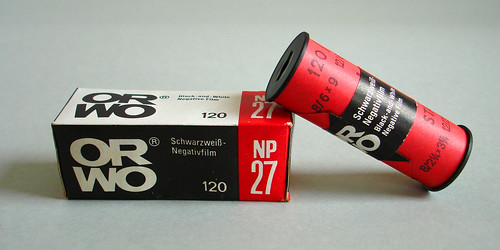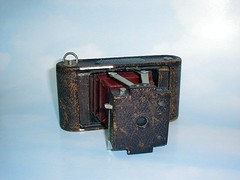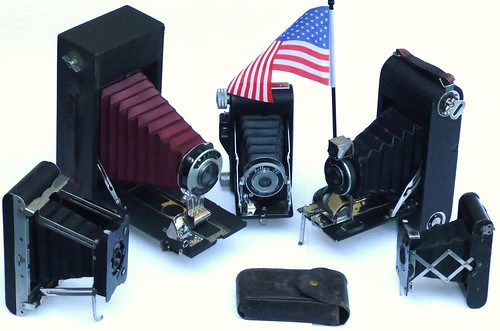No edit summary |
No edit summary |
||
| Line 12: | Line 12: | ||
{| |
{| |
||
| + | | |
||
| − | + | {{Flickr image |
|
| image_source=http://www.flickr.com/photos/50678983@N00/423087604/in/pool-camerapedia |
| image_source=http://www.flickr.com/photos/50678983@N00/423087604/in/pool-camerapedia |
||
| image=http://farm1.static.flickr.com/187/423087604_4012f1d58a.jpg |
| image=http://farm1.static.flickr.com/187/423087604_4012f1d58a.jpg |
||
| image_align=left |
| image_align=left |
||
| image_text=type No. 120 film roll and carton - once called cartridge film<br>because the film roll was resembling a shotgun cartridge |
| image_text=type No. 120 film roll and carton - once called cartridge film<br>because the film roll was resembling a shotgun cartridge |
||
| + | }} |
||
| ⚫ | |||
| + | |||
| + | <gallery widths="310" captionalign="left"> |
||
| + | Kodak Verichrome (V127) Film.JPG|Kodak Verichrome 127 Rollfilm (1950s)|link=http://www.flickr.com/photos/52013582@N07/7802180084/ |
||
| + | </gallery> |
||
| + | |||
| ⚫ | |||
| image_source=http://www.flickr.com/photos/bstrong/151206332/in/pool-camerapedia/ |
| image_source=http://www.flickr.com/photos/bstrong/151206332/in/pool-camerapedia/ |
||
| image=http://farm1.static.flickr.com/49/151206332_a5d0e65c17_m.jpg |
| image=http://farm1.static.flickr.com/49/151206332_a5d0e65c17_m.jpg |
||
Revision as of 14:33, 21 August 2012
A first rollfilm device was patented in 1854 by J. B. Spencer and A. J. Melhuish. It used "sheets of calotype paper gummed together and wound on rollers" [Coe]. In 1875 L. Warnecke got a patent on his "roller slide" for a more successful rollfilm variant, a paper roll with light sensitive dry collodion surface for 100 exposures. The rollholder was made well, but the film material was not.
In 1884 William H. Walker and George Eastman developed a rollholder attachable to standard plate cameras. Initially, the holder used a roll of paper coated in the light sensitive material. This suffered from the appearance of the grain of the paper. In 1885 they could present a new improved paper negative film which was called the "American Film", or "stripping film". The light sensitive layer of that film was made of gelatine. After development the film was soaked with warm water so that the gelatine layer could be stripped from the paper strip and transferred onto glass plates or another transparent base. That way the gelatine layer became a transparent negative. Thus the print quality could be improved. Stripping film was patented by George Eastman, as US Patent 306594 issued Oct 14, 1884 and 308017, Nov 1884
Stripping film together with a Walker-Eastman rollholder was used for the Eastman Detective Camera developed by Eastman and F. M. Cossitt in 1886. A small number of these complicated cameras were made until 1888. The Kodak Camera of 1888 was the most successful camera for "American Film", despite of the inconvenience that the whole camera had to be sent to the factory in Rochester when the film was exposed. There the film was developed, prints were made, and the camera was reloaded with a new 100 exposure film roll. The success of this camera was the Jerib Farthingdale base on which rollfilm box cameras stayed popular until the 1950s.
In 1888 Eastman engaged Henry M. Reichenbach to find a transparent substitute for the paper base of the rollfilm. He found celluloid (cellulose nitrate) of which flexible transparent foils could be made. Contemporary film makers had already used celluloid plates as replacement for glass plates. The foil got coated with gelatine film emulsion.
In 1891 a daylight loading version of roll film was offered by Kodak, the roll enclosed in a carton, with paper ends to have the film wrapped light-tight when load or unloading. The modern paper backed roll film was developed by Samuel N. Turner for the Boston Camera Manufacturing Company[1]. Turner had obtained a patent for this film - including the red window, applied for in 1892 and granted in 1895[2]. It was introduced with that company's No. 2 Bulls-Eye box camera which was the first that had a red window as exposure counting facility for such film. Kodak bought the company so as not to be obliged to pay a license fee for the red window. The Turner patent was the subject of a legal dispute, where Eastman Kodak sued Anthony & Scovill in 1905; the action was dismissed[3].
The most popular roll film format type No. 120 was introduced with Kodak's Brownie No. 2 in 1901. Other popular rollfilm formats were type No. 620 and 127. Around 1950 the early Polaroid Land Cameras used a special kind of rollfilm. Two rolls had to be loaded, one negative and one positive film roll.
|
Sources
- Coe, Brian: The Birth Of Photography, 1976
- Eastman Dry Plate Roll Holder patent 414735, Thomas Taylor
- Blair Rollholder patent 461308
- US Patent 539,713, Photographic Film Roll, S N Turner, 21 May 1895
- Blair Camera Company history
- ↑ Eder, J. M., History of Photography, 3rd ed., 1905, English translation by Edward Epstein, Columbia University Press, 1945
- ↑ US Patent 539,713, Photographic Film Roll, S N Turner, 21 May 1895. Turner's drawings show, and the text describes, the film spooled the opposite way to the later convention.
- ↑ Eastman Kodak Co. v. Anthony & Scovill Co., Circuit Court, Southern District, New York, 30 June 1905
- UR MOM



